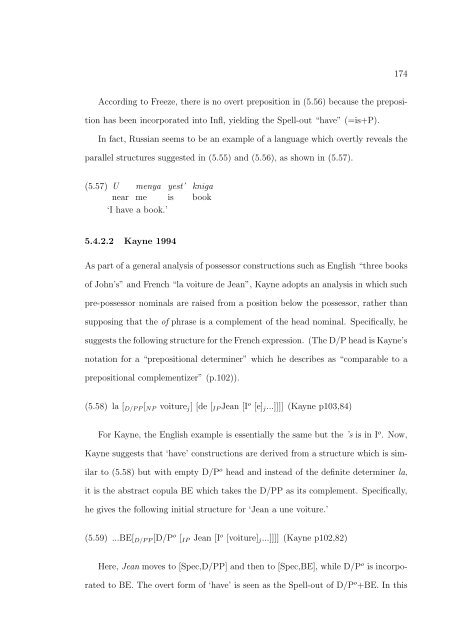the syntax and semantics of relativization and quantification
the syntax and semantics of relativization and quantification
the syntax and semantics of relativization and quantification
You also want an ePaper? Increase the reach of your titles
YUMPU automatically turns print PDFs into web optimized ePapers that Google loves.
174<br />
According to Freeze, <strong>the</strong>re is no overt preposition in (5.56) because <strong>the</strong> preposition<br />
has been incorporated into Infl, yielding <strong>the</strong> Spell-out “have” (=is+P).<br />
In fact, Russian seems to be an example <strong>of</strong> a language which overtly reveals <strong>the</strong><br />
parallel structures suggested in (5.55) <strong>and</strong> (5.56), as shown in (5.57).<br />
(5.57) U<br />
near<br />
menya<br />
me<br />
yest’<br />
is<br />
‘I have a book.’<br />
kniga<br />
book<br />
5.4.2.2 Kayne 1994<br />
As part <strong>of</strong> a general analysis <strong>of</strong> possessor constructions such as English “three books<br />
<strong>of</strong> John’s” <strong>and</strong> French “la voiture de Jean”, Kayne adopts an analysis in which such<br />
pre-possessor nominals are raised from a position below <strong>the</strong> possessor, ra<strong>the</strong>r than<br />
supposing that <strong>the</strong> <strong>of</strong> phrase is a complement <strong>of</strong> <strong>the</strong> head nominal. Specifically, he<br />
suggests <strong>the</strong> following structure for <strong>the</strong> French expression. (The D/P head is Kayne’s<br />
notation for a “prepositional determiner” which he describes as “comparable to a<br />
prepositional complementizer” (p.102)).<br />
(5.58) la [ D/PP [ NP voiture j ] [de [ IP Jean [I o [e] j ...]]]] (Kayne p103,84)<br />
For Kayne, <strong>the</strong> English example is essentially <strong>the</strong> same but <strong>the</strong> ’s is in I o . Now,<br />
Kayne suggests that ‘have’ constructions are derived from a structure which is similar<br />
to (5.58) but with empty D/P o head <strong>and</strong> instead <strong>of</strong> <strong>the</strong> definite determiner la,<br />
it is <strong>the</strong> abstract copula BE which takes <strong>the</strong> D/PP as its complement. Specifically,<br />
he gives <strong>the</strong> following initial structure for ‘Jean a une voiture.’<br />
(5.59) ...BE[ D/PP [D/P o [ IP Jean [I o [voiture] j ...]]]] (Kayne p102,82)<br />
Here, Jean moves to [Spec,D/PP] <strong>and</strong> <strong>the</strong>n to [Spec,BE], while D/P o is incorporated<br />
to BE. The overt form <strong>of</strong> ‘have’ is seen as <strong>the</strong> Spell-out <strong>of</strong> D/P o +BE. In this
















